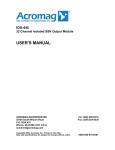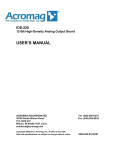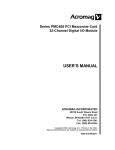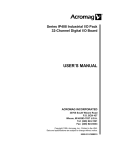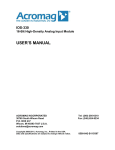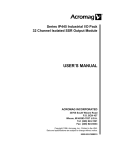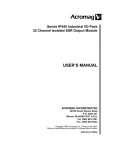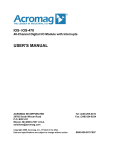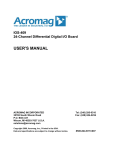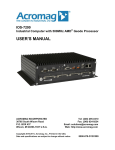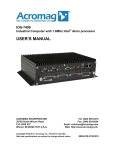Download IOS-408 User`s Manual
Transcript
IOS-408 32-Channel Digital I/O Board USER’S MANUAL ACROMAG INCORPORATED 30765 South Wixom Road P.O. BOX 437 Wixom, MI 48393-7037 U.S.A. [email protected] Copyright 2009, Acromag, Inc., Printed in the USA. Data and specifications are subject to change without notice. Tel: (248) 295-0310 Fax: (248) 624-9234 8500-841-B11C007 SERIES IOS-408 I/O SERVER MODULE 32-CHANNEL DIGITAL I/O MODULE __________________________________________________________________________________________ The information contained in this manual is subject to change without notice. Acromag, Inc. makes no warranty of any kind with regard to this material, including, but not limited to, the implied warranties of merchantability and fitness for a particular purpose. Further, Acromag, Inc. assumes no responsibility for any errors that may appear in this manual and makes no commitment to update, or keep current, the information contained in this manual. No part of this manual may be copied or reproduced in any form, without the prior written consent of Acromag, Inc. Table of Contents 1.0 GENERAL INFORMATION........................................... KEY IOS-408 FEATURES............................................. I/O SERVER MODULE INTERFACE FEATURES........ I/O SERVER MODULE SOFTWARE LIBRARY........... 2.0 PREPARATION FOR USE............................................ UNPACKING AND INSPECTION.................................. BOARD CONFIGURATION........................................... CONNECTORS............................................................. IOS Field I/O Connector (P2)..................................... I/O Noise and Grounding Considerations.................. Output Off-State Loading Considerations.................. 3.0 PROGRAMMING INFORMATION................................. ADDRESS MAPS.......................................................... IOS Digital Input Registers A & B.............................. IOS Digital Output Registers A & B........................... Interrupt Enable Register........................................... Interrupt Type Configuration Register........................ Interrupt Polarity Register.......................................... Interrupt Status Register............................................ Interrupt Vector Register........................................... IOS Identification PROM........................................... IOS-408 PROGRAMMING CONSIDERATIONS............ Programming Interrupts............................................ 4.0 THEORY OF OPERATION............................................ INPUT/OUTPUT............................................................ 5.0 SERVICE AND REPAIR................................................ SERVICE AND REPAIR ASSISTANCE........................ PRELIMINARY SERVICE PROCEDURE...................... WHERE TO GET HELP………………………………….. 6.0 SPECIFICATIONS......................................................... GENERAL SPECIFICATIONS....................................... DIGITAL INPUTS.......................................................... DIGITAL OUTPUTS...................................................... OUTPUT MOSFETS..................................................... DRAWINGS IOS-408 BLOCK DIAGRAM.......................... IOS-408 EXAMPLE OUTPUT CONNECTIONS IOS-408 EXAMPLE INPUT CONNECTIONS.. Page 2 2 3 3 3 3 3 3 4 4 4 4 4 5 5 5 5 6 6 6 6 7 7 8 8 9 9 9 9 10 10 10 10 10 Page 11 12 12 IMPORTANT SAFETY CONSIDERATIONS It is very important for the user to consider the possible adverse effects of power, wiring, component, sensor, or software failures in designing any type of control or monitoring system. This is especially important where economic property loss or human life is involved. It is important that the user employ satisfactory overall system design. It is agreed between the Buyer and Acromag, that this is the Buyer's responsibility. 1.0 GENERAL INFORMATION The I/O SERVER MODULE (IOS) Series IOS-408 module is a 32-channel combination digital input/output board. This model supports both 0 to 60V DC inputs, and 60VDC low-side switch outputs, in any combination up to 32 channels. Four units mounted on a carrier board provide up to 128 I/O points per 6U-VMEbus system slot. As a combination input/output module, input channels on this model can be used for “loopback” monitoring of the output channel states. Up to 8 input channels can be programmed to generate Change-Of-State (COS), Low, or High level transition interrupts. The IOS-408 utilizes state of the art Surface-Mounted Technology (SMT) to achieve its high channel density and is an ideal choice for a wide range of industrial control and monitor applications that require high-density, high-reliability, and highperformance at a low cost. The IOS-408 standard temperature range is (-40oC to +85oC). Important Note: The following IOS model are accessories to the IOS Server Models: IOS-7200, IOS-7200-WIN, IOS-7400, and IOS7400-WIN; which are cULus Listed. This equipment is suitable for use in Class I, Division 2, Groups A, B, C, and D or non-hazardous locations only. KEY IOS-408 FEATURES High Channel Count - Interfaces with up to 32 input/output points. Four units mounted on a carrier board provide up to 128 input and/or output channels in a single system slot. Input and output channels may be intermixed in any combination. The input circuitry of a single channel can also be used to monitor the output state of the same channel to efficiently implement “loopback” output control. TTL-Compatible Input Threshold - Input threshold is at TTL levels and includes hysteresis. Input Hysteresis - Buffered inputs include hysteresis for increased noise immunity. Programmable Change-of-State/Level Interrupts Interrupts are software programmable for any bit Change-OfState or level on up to 8 channels. Loopback Output Control & Fault Diagnostics - Input and output circuitry is connected in tandem to each I/O channel, making it directly compatible for “loopback monitoring” of the output channel states. This feature can also be used to implement self-test or fault diagnosis, since inherent loopback can be used to detect open output switches or shorts. High Voltage Inputs & Outputs - Inputs and outputs are rated to 60VDC. I/O channels are non-isolated and share a common connection. High Impedance Inputs - High impedance inputs minimize loading of the input source and input current. -2Acromag, Inc. Tel:248-295-0310 Fax:248-624-9234 Email:[email protected] http://www.acromag.com SERIES IOS-408 I/O SERVER MODULE 32-CHANNEL DIGITAL I/O MODULE __________________________________________________________________________________________ No Configuration Jumpers or Switches - All configuration is performed through software commands with no internal jumpers to configure or switches to set. Power Up & System Reset is Failsafe - For safety, the outputs are always OFF upon power-up and cleared after a system reset. Unlike some competitive units, output gate pulldowns are included to ensure that the outputs do not turn on momentarily when output load power is applied with no power to the IOS module. True Logic - Outputs operate using True-Logic (1=ON/SWITCH CLOSED, 0=OFF/SWITCH OPEN). Low RdsON (0.2 Maximum)- Low output drain-to-source ON resistance ensures TTL logic-low compatibility at high currents and reduces power dissipation. High Output Current - individual output channels may sink up to 1A DC continuous (up to 10A total, all channels combined), or 312mA DC (with all 32 channels ON). No deration of maximum output current is required at elevated ambient temperatures. Conduction Cooled Module - I/O modules employ advanced thermal technologies. A thermal pad and module cover wicks heat away from the module and transfers the energy to a heat spreading friction plate. Heat moves to the enclosure walls where it is dissipated by the external cooling fins. I/O SERVER MODULE INTERFACE FEATURES High density - Single-size, IOS module footprint. Up to four units may be mounted on a 6U VMEbus carrier board. Local ID - Each IOS module has its own 8-bit ID PROM which is accessed via data transfers in the "ID Read" space. 16-bit & 8-bit I/O - Channel register Read/Write is performed through D16 or D08 (EO) data transfer cycles. badly damaged or water stained, request that the carrier's agent be present when the carton is opened. If the carrier's agent is absent when the carton is opened and the contents of the carton are damaged, keep the carton and packing material for the agent's inspection. For repairs to a product damaged in shipment, refer to the Acromag Service Policy to obtain return instructions. It is suggested that salvageable shipping cartons and packing material be saved for future use in the event the product must be shipped. This board is physically protected with packing material and electrically protected with an anti static bag during shipment. However, it is recommended that the board be visually inspected for evidence of mishandling prior to applying power. The board utilizes static sensitive components and should only be handled at a static-safe workstation. BOARD CONFIGURATION I/O SERVER MODULE SOFTWARE LIBRARY Power should be removed from the board when installing IOS modules, cables, termination panels, and field wiring. Refer to your IOS module documentation for configuration and assembly instructions. Model IOS-408 I/O Boards have no jumpers or switches to configure--interrupts are configured through software command. IOS MODULE Win32 DRIVER SOFTWARE CONNECTORS Acromag provides a software product (sold separately) to facilitate the development of Windows Embedded Standard applications interfacing with I/O Server Modules installed on Acromag Industrial I/O Server systems. This software (Model IOSSW-DEV-WIN) consists of a low-level driver and Windows 32 Dynamic Link Libraries (DLLS) that are compatible with a number of programming environments including Visual C++, Visual Basic.NET, Borland C++ Builder and others. The DLL functions provide a high-level interface to the IOS carrier and modules eliminating the need to perform low-level reads/writes of registers, and the writing of interrupt handlers. IOS Field I/O Connector (P2) IOS MODULE LINUX SOFTWARE Acromag provides a software product (sold separately) consisting of Linux software. This software (Model IOSSW-APILNX) is composed of Linux libraries designed to support applications accessing I/O Server Modules installed on Acromag Industrial I/O Server systems. The software is implemented as a library of “C” functions which link with existing user code. P2 provides the field I/O interface connector for mating IOS modules to the carrier board. P2 is a 50-pin female receptacle header (AMP 173279-3 or equivalent) which mates to the male connector of the carrier board (AMP 173280-3 or equivalent). This provides excellent connection integrity and utilizes gold-plating in the mating area. The field and logic side connectors are keyed to avoid incorrect assembly. P2 pin assignments are unique to each IOS model (see Table 2.1) and correspond to the pin numbers of the front-panel, field-I/O interface connector on the carrier board. The P2 pin assignments of the IOS-408 I/O module correspond with those of the IOS-400 input module and the IOS-405 output module (for channels 0-31 and common). 2.0 PREPARATION FOR USE UNPACKING AND INSPECTION Upon receipt of this product, inspect the shipping carton for evidence of mishandling during transit. If the shipping carton is -3Acromag, Inc. Tel:248-295-0310 Fax:248-624-9234 Email:[email protected] http://www.acromag.com SERIES IOS-408 I/O SERVER MODULE 32-CHANNEL DIGITAL I/O MODULE __________________________________________________________________________________________ Table 2.1: IOS-408 Field I/O Pin Connections (P2) Pin Description OD00 OD01 OD02 OD03 OD04 OD05 OD06 OD07 OD08 OD09 OD10 OD11 OD12 OD13 OD14 OD15 OD16 OD17 OD18 OD19 OD20 OD21 OD22 OD23 OD24 Number 1 2 3 4 6 7 8 9 11 12 13 14 16 17 18 19 21 22 23 24 26 27 28 29 31 Pin Description OD25 OD26 OD27 OD28 OD29 OD30 OD31 Not Used Not Used Not Used Not Used Not Used Not Used Not Used Not Used COMMON COMMON COMMON COMMON COMMON COMMON COMMON COMMON COMMON COMMON Number 32 33 34 36 37 38 39 41 42 43 44 46 47 48 49 5 10 15 20 25 30 35 40 45 50 I/O Noise and Grounding Considerations The output channels of this model are the open drains of mosfets with a common source connection. The IOS-408 is nonisolated between the logic and field I/O grounds since output common is electrically connected to the IOS module ground. Consequently, the field I/O connections are not isolated from the carrier board and backplane. Two ounce copper ground plane foil has been employed in the design of this model to help minimize the effects of ground bounce, impedance drops, and switching transients. However, care should be taken in designing installations without isolation to avoid noise pickup and ground loops caused by multiple ground connections. This device is capable of switching many channels at high currents. Additionally, the nature of the IOS interface is inherently inductive. The outputs of this model are protected to voltages up to 60V. As such, when switching inductive loads, it is important that careful consideration be given to the use of snubber devices to shunt the reverse emf that develops when the current through an inductor is interrupted. Filtering and bypassing at the load may also be necessary. Additionally, proper grounding with thick conductors is essential. Interface cabling and ground wiring should be kept as short as possible. For outputs, the use of an interposing relay may also be desireable for isolating the load, raising the drive capability, or providing additional system protection. Please refer to IOS-408 Example Output Connections & Ios-408 Example Input Connections diagram at the end of this manual for examples of these connections and proper output and grounding connections. Output Off-State Loading Considerations With respect to output control, the 100K input buffer currentlimiting resistors in combination with +4.7V voltage clamps will tend to increase the off-state drain current with increased drain voltage (up to 0.5mA at 60V). This is due to the fact that the input buffer circuitry and output mosfet drain circuitry are connected in tandem to the same I/O pin. If this presents a problem for your application, then you should consider separating the inputs and outputs by using other IOS modules like the Acromag IOS-400 40-channel input board and the IOS-405 40-channel output board. 3.0 PROGRAMMING INFORMATION ADDRESS MAPS This board is addressable in the Industrial Pack I/O space to control the ON/OFF states of individual low-side switches and/or the acquisition of digital inputs from the field. The I/O space may be as large as 64, 16-bit words (128 bytes), but the IOS-408 only uses a portion of this space. The I/O space address map for the IOS-408 is shown in Table 3.1. Note the base address for the IOS module I/O space (refer to the I/O Server manual) must be added to the addresses shown to properly access the I/O space. Accesses can be performed on an 8-bit or 16-bit basis. Table 3.1: IOS-408 I/O Space Address (Hex) Memory Map HIGH LOW Base HIGH Byte LOW Byte Base Addr.+ D15 D08 D07 D00 Addr.+ 01 READ- Digital Input READ- Digital Input Channel Register A Channel Register A CH15 CH08 CH07 CH00 00 03 READ- Digital Input READ- Digital Input Channel Register B Channel Register B CH31 CH24 CH23 CH16 02 05 R/W -Digital Output R/W -Digital Output Channel Register A Channel Register A CH15 CH08 CH07 CH00 04 07 R/W - Digital Output R/W -Digital Output Channel Register B Channel Register B CH31 CH24 CH23 CH16 06 09 R/W - Interrupt NOT DRIVEN Enable Register1 CH07 CH00 08 0B R/W -Interrupt Type NOT DRIVEN Config. Register1 CH07 CH00 0A 0D R/W - Interrupt NOT DRIVEN Polarity Register1 CH07 CH00 0C 0F R/W - Interrupt NOT DRIVEN Status Register1 CH07 CH00 0E 11 R/W - Interrupt NOT DRIVEN Vector Register1 10 13 12 NOT USED2 7F 7E Notes (Table 3.1): 1. The upper 8 bits of this register are not driven. Pullups on the carrier board data bus will cause these bits to always read high (1‟s). 2. The IOS will not respond to addresses that are "Not Used". IOS Digital Input Registers A & B (Read Only) -4Acromag, Inc. Tel:248-295-0310 Fax:248-624-9234 Email:[email protected] http://www.acromag.com SERIES IOS-408 I/O SERVER MODULE 32-CHANNEL DIGITAL I/O MODULE __________________________________________________________________________________________ When the Digital Input Channel Data Registers are read, the value read corresponds to the actual state of the input channels at the time of the read. If the channel‟s tandem output mosfet is being controlled and its drain is loaded, then reading the digital input channel data register will return the state of the output (it is directly connected to the drain). This is an efficient method of accomplishing “loopback” control of the output. A “0” bit means that the corresponding input signal is below the threshold value (or the tandem output mosfet is ON), a “1” bit means that the corresponding input signal is at or above the threshold value (or the tandem mosfet is OFF and pulled up). Thirty-two possible input channels numbered 0 through 31 may be read. Channel read operations use 8-bit (D08(EO)), or 16-bit (D16) data transfers with the lower ordered bits corresponding to the lower-numbered channels for the register of interest (see below). Register A monitors input channels 0 through 15. Register B monitors input channels 16 through 31. It is recommended that unused inputs not be left floating, but pulled low by turning on the corresponding tandem output (see IOS Digital Output Registers). REGISTER B (OUTPUT SWITCHES 16 THROUGH 31): MSB _ _ _ _ _ _ _ _ _ _ _ _ _ _ LSB 15 14 13 12 11 10 9 8 7 6 5 4 3 2 1 0 CH31.................................CH24 CH23...............................CH16 Each output channel register can be conveniently read back for verification purposes. However, for critical control applications, it is recommended that outputs be directly fed back to input points and the input points monitored (loopback I/O). By design, input channels are tied to the drains of the tandem output mosfet and a read of the input channel register will return the inverse of a read of the output channel register (a read of the input returns the drain level, a read of the output returns the gate level). This is an efficient method of accomplishing loopback output control without requiring additional channels. However, this only applies for a loaded drain (a pullup or other load connected to the drain). All outputs are OFF (switch OPEN) following a power-on reset, and are immediately cleared following a system reset. It is recommended that unused outputs be turned on so that the corresponding unused inputs are pulled low, rather than floating. Interrupt Enable Register (R/W) REGISTER A (INPUT CHANNELS 0 THROUGH 15): MSB _ _ _ _ _ _ _ _ _ _ _ _ _ _ LSB 15 14 13 12 11 10 9 8 7 6 5 4 3 2 1 0 CH15...................... ............CH8 CH7..................................CH0 REGISTER B (INPUT CHANNELS 16 THROUGH 31): MSB _ _ _ _ _ _ _ _ _ _ _ _ _ LSB 15 14 13 12 11 10 9 8 7 6 5 4 3 2 1 0 CH31..................................CH24 CH23............................CH16 IOS Digital Output Registers A & B (Read/Write) When the Digital Output Channel Data Registers are written to, the value written is represented at the corresponding output channels. A “0” bit means that the corresponding output switch is OPEN (OFF). Writing a “1” bit CLOSES the corresponding output switch (turns it ON). There are two ways to accomplish an output read. Reading the digital output channel register returns the state configuration of this register (which is equivalent to the output mosfet gate signal). Since input channels operate in tandem with the output channels, reading the digital input channel register will return the actual state of the output (it returns the level of the output mosfet drain). That is, writing a „1‟ to an output turns the switch ON (gate signal high). In turn, this drives the drain low (mosfet is conducting). As such, a read of the input channel register will be the inverse of a read of the output channel register for a loaded output channel. Read/Write Control for 32 output channels numbered 0 through 31 is provided. Channel state Read/Write operations use 8-bit even or odd-byte, or 16-bit data transfers with the lower ordered bits corresponding to the lower-numbered channels for the register of interest (see below). Register A controls output channels 0 through 15. Register B controls output channels 16 through 31. REGISTER A (OUTPUT SWITCHES 0 THROUGH 15): MSB _ _ _ _ _ _ _ _ _ _ _ _ _ _ LSB 15 14 13 12 11 10 9 8 7 6 5 4 3 2 1 0 CH15..................................CH08 CH7..................................CH0 The digital input channel Interrupt Enable Registers provide a mask bit for each of the 8 possible interrupt channels (channels 0-7 only). A “0” bit will prevent the corresponding input channel from generating an external interrupt. A “1” bit will allow the corresponding input channel to generate an interrupt. The unused upper 8 bits of these 16-bit registers are “Don‟t Care” and will always read high (1‟s) for D16 accesses. INTERRUPT ENABLE REGISTER: MSB _ _ _ _ _ _ _ _ _ _ _ _ _ _ LSB 15 14 13 12 11 10 9 8 7 6 5 4 3 2 1 0 X X X X X X X X CH7...................................CH0 All input channel interrupts are masked (“0”) following a reset. Interrupt Type (COS or H/L) Configuration Register (R/W) The Interrupt Type Configuration Registers determine the type of input channel transition that will generate an interrupt for each of the 8 possible interrupt channels (channels 0-7 only). A “0” bit means that an interrupt will be generated when the input channel level specified by the Interrupt Polarity Register occurs (i.e. Low or High level transition interrupt). A “1” bit means the interrupt will occur when a Change-Of-State (COS) occurs at the corresponding input channel (i.e. any state transition). The unused upper 8 bits of these 16-bit registers are “Don‟t Care” and will always read high (1‟s) for D16 accesses. Note that interrupts will not occur unless they are enabled. INTERRUPT TYPE (COS or H/L) CONFIGURATION REGISTER: MSB _ _ _ _ _ _ _ _ _ _ _ _ _ _ LSB 15 14 13 12 11 10 9 8 7 6 5 4 3 2 1 0 X X X X X X X X CH7..................................CH0 All bits are set to “0” following a reset which means that the inputs will cause interrupts for the levels specified by the digital input channel Interrupt Polarity Register. -5Acromag, Inc. Tel:248-295-0310 Fax:248-624-9234 Email:[email protected] http://www.acromag.com SERIES IOS-408 I/O SERVER MODULE 32-CHANNEL DIGITAL I/O MODULE __________________________________________________________________________________________ Interrupt Polarity Register (R/W) The Interrupt Polarity Register determines the level that will cause a channel interrupt to occur for each of the 8 possible interrupt channels (channels 0-7 only). A “0” bit specifies that an interrupt will occur when the corresponding input channel is BELOW TTL threshold (i.e. a “0” in the digital input channel data register). A “1” bit means that an interrupt will occur when the input channel is ABOVE TTL threshold (i.e. a “1” in the digital input channel data register). Note that no interrupts will occur unless they are enabled by the Interrupt Enable Register. Further, the Interrupt Polarity Register will have no effect if the Change-of-State (COS) interrupt type is configured by the Interrupt Type Configuration Register. INTERRUPT POLARITY (HIGH/LOW) REGISTER: MSB _ _ _ _ _ _ _ _ _ _ _ _ _ _ LSB 15 14 13 12 11 10 9 8 7 6 5 4 3 2 1 0 X X X X X X X X CH7..................................CH0 The unused upper 8 bits of these 16-bit registers are “Don‟t Care” and will always read high (1‟s) for D16 accesses. All bits are set to “0” following a reset which means that the inputs will cause interrupts when they are below TTL threshold. Interrupt Status Register (R/W) The Interrupt Status Register reflects the status of the 8 possible interrupt channels (channels 0-7 only). A “1” bit indicates that an interrupt is pending for the corresponding channel. A channel that does not have interrupts enabled will never set its interrupt status flag. A channel‟s interrupt can be cleared by writing a “1” to its bit position in the Interrupt Status Register (writing a “1” acts as a reset signal to clear the set state). This is known as the “Release On Register Access” (RORA) method, as defined in the VME system architecture specification. However, if the condition which caused the interrupt to occur remains, the interrupt will be generated again (unless disabled via the Interrupt Enable Register). Note that interrupts are prioritized via hardware within the card. Channel 7 has the highest priority, channel 0 the lowest priority. If multiple input channel interrupts become pending at the same time, the vector corresponding to the highest numbered channel will be delivered first. After the highest numbered channel‟s interrupt is serviced and cleared, an additional interrupt will be generated for the next highest priority channel with an interrupt pending. Note that the input channel bandwidth should be limited to reduce the possibility of missing channel interrupts. For a specific input channel, this could happen if multiple changes occur before the channel‟s interrupt is serviced. INTERRUPT STATUS REGISTER: MSB _ _ _ _ _ _ _ _ _ _ _ _ _ _ LSB 15 14 13 12 11 10 9 8 7 6 5 4 3 2 1 0 X X X X X X X X CH7...................................CH0 All interrupts are cleared following a reset. Interrupt Vector Register (R/W) The Interrupt Vector Register maintains an 8-bit interrupt pointer for each of the 8 digital input channel interrupt lines (channels 0-7 only). The lower 3 bits of the Interrupt Vector Register (odd byte address) contain the channel number that originated the interrupt. The upper 5 bits of the odd-addressed byte are user-programmable and contain a pointer to the interrupt service routine. Interrupts are served on a priority basis with the higher numbered channels having higher priority (i.e. channel 7 has the highest priority, channel 0 the lowest). The appropriate interrupt vector is given to the VMEbus Interrupt Handler when an interrupt is being serviced. As such, it is a pointer to 8 possible interrupt handling routines. This allows each digital input channel to be serviced by its own software handler. INTERRUPT VECTOR REGISTER: MSB _ _ _ _ _ _ _ _ _ _ _ _ 15 14 13 12 11 10 9 8 7 6 5 4 3 X X X X X X X X User-Programmable _ _ LSB 2 1 0 Channel No. All bits of this register are set to “0” following a reset. IOS ID PROM (Read Only, 32 even-byte addresses) Each IOS module contains an identification (ID) PROM that resides in the ID space. This area of memory contains 32 bytes of information at most. Both fixed and variable information may be present within the ID PROM. Fixed information includes the "IOS" identifier, model number, and manufacturer's identification codes. Variable information includes unique information required for the module. The IOS-408 ID PROM does not contain any variable (e.g. unique calibration) information. ID PROM bytes are addressed using only the even addresses in a 64 byte block. The IOS-408 ID PROM contents are shown in Table 3.2. Note that the base-address for the IOS module ID space (refer to the I/O Server manual) must be added to the addresses shown to properly access the ID PROM. Execution of an ID PROM Read operation requires 1 wait state. Table 3.2: IOS-408 ID Space Identification (ID) PROM Hex Offset From ID Numeric PROM Base Value Address (Hex) Field Description 00 49 02 50 04 41 06 43 08 A3 Acromag ID Code 0A 03 IOS Model Code1 0C 00 Not Used (Revision) 0E 00 Reserved 10 00 Not Used 12 00 Not Used 14 0C Total Number of ID ROM Bytes 16 C2 CRC 18 to 3E 00 Not Used Notes (Table 3.2): 1. The IOS model number is represented by a two-digit code within the ID PROM (the IOS-408 model is represented by 03 Hex). IOS-408 PROGRAMMING CONSIDERATIONS -6Acromag, Inc. Tel:248-295-0310 Fax:248-624-9234 Email:[email protected] http://www.acromag.com SERIES IOS-408 I/O SERVER MODULE 32-CHANNEL DIGITAL I/O MODULE __________________________________________________________________________________________ Programming Interrupts Processing Change-of-State Interrupts: Digital input channels can be programmed to generate interrupts for the following conditions (channels 0-7 only): Change-of-State (COS) at selected channels. Input level (polarity) match at selected input channels. Interrupts generated by the IOS-408 use interrupt request line INTREQ0* (Interrupt Request 0). The interrupt release mechanism employed is the Release On Register Access (RORA) type. This means that the interrupter will release the I/O SERVER MODULE interrupt request line (INTREQ0) after the interrupt has been cleared by writing a “1” to the appropriate bit position in the input channel Interrupt Status Register. The Interrupt Vector Register contains information regarding the interrupting channels. The lower 3 bits of this 8-bit number contain the channel number of the interrupting channel. The upper 5 bits of this 8-bit number contain user-programmable information. Interrupt service is prioritized with the higher numbered channel having a higher priority over the lower numbered channels. Thus, Channel 7 has the highest priority and channel 0 the lowest. As such, if multiple channel interrupts become pending at the same time, the pointer corresponding to the highest numbered channel will be delivered first. After the highest numbered channel interrupt is serviced and cleared, an additional interrupt will be generated for the next highest priority (pending) interrupt. When using interrupts, input channel bandwidth should be limited to reduce the possiblity of missing channel interrupts. For a given input channel, this could happen if multiple changes occur before the channel‟s interrupt is serviced. The response time of the input channels should also be considered when figuring this bandwidth. The total response time is the sum of the input buffer response time, plus the interrupt logic circuit response time, and this time must pass before another interrupt condition will be recognized. The following programming examples assume that the IOS-408 is installed onto an Acromag I/O Server carrier board. Interrupt Programming Example 1. Clear the Interrupt Enable Bits in the Carrier Board Status Register by writing a "0" to bit 2 and bit 3. 2. Perform Specific IOS-408 Module Programming - see the Change-of-State or Level (Polarity) Match programming examples that follow, as required for your application. 3. Write a “1” to bit 2 of the Carrier Status/Control Register Module Interrupt Enable bit to enable IOS module interrupts to the PCI bus. Programming Example for Change-of-State Interrupts: 1. Select channel Change-of-State interrupts by writing a “1” to each channel‟s respective bit in the Interrupt Type Register. Note that Change-Of-State interrupts (specified with “1”) may be mixed with polarity match interrupts (specified with “0”). 3. Enable individual input channel interrupts by writing a “1” to each channel‟s respective bit in the Interrupt Enable Register. 4. Clear pending interrupts by writing a “1” to each channel‟s respective bit in the Interrupt Status Register. Change-of-State Interrupts may now be generated by the input channels programmed above for any Change-Of-State transition. 1. Clear the interrupting channel(s) by writing a “1” to the appropriate bits in the IOS-408 Interrupt Status Register. Programming Example for Level (Polarity) Match Interrupts: 1. Select channel Polarity Match Interrupts by writing a “0” to each channel‟s respective bit in the Interrupt Type Register. Note that Change-Of-State interrupts (specified with “1”) may be mixed with Polarity Match Interrupts (specified with “0”). 3. Select the desired polarity (High/Low) level for interrupts by writing a “0” (Low), or “1” (High) level to each channel‟s respective bit in the Interrupt Polarity Register. 4. Enable individual input channel interrupts by writing a “1” to each channel‟s respective bit in the Interrupt Enable Register. 5. Clear pending interrupts by writing a “1” to each channel‟s respective bit in the Interrupt Status Register. Interrupts can now be generated by matching the input level with the selected polarity for programmed interrupt channels. Processing Level (Polarity) Match Interrupts: 1. Disable the interrupting channel(s) by writing a “0” to the appropriate bits in the IOS-408 Interrupt Enable Register. 2. After the interrupt stimulus has been removed, clear the interrupting channel(s) by writing a “1” to the appropriate bits in the IOS-408 Interrupt Status Register. If the input stimulus is still applied, this will not clear the Interrupt Status Register bit and the interrupting channel(s) must remain disabled until the interrupt stimulus has been removed. After removal of the input stimulus the channel(s) may be cleared and re-enabled. 3. Re-enable the interrupting channel(s) by writing a “1” to the appropriate bits in the Interrupt Enable Register. General Sequence of Events for Processing an Interrupt 1. The IOS-408 asserts the Interrupt Request 0 Line (INTREQ0*) in response to an interrupt condition at one or more inputs. 2. A generated interrupt is recognized by the carrier board and is recorded in the carrier board‟s Interrupt Pending Register and passed to the PCI bus by driving interrupt request signal INTA# active. 3. The host processor uses the PCI interrupt to locate an interrupt service routine to process interrupts from the carrier board. 4. The carrier board interrupt service routine examines the carrier board‟s Interrupt Pending Register and invokes IOS module interrupt service routines to service individual IOS modules. 3. The carrier board interrupt service routine accesses the interrupt space of the IOS module selected to be serviced. Note that the interrupt space accessed must correspond to the interrupt request signal driven by the IOS module. 4. The carrier board will assert the INTSEL* signal to the appropriate IOS module together with (carrier board generated) address bit A1 to select which interrupt request is being processed (A1 low corresponds to INTREQ0*; A1 high corresponds to INTREQ1*). 5. The IOS module receives an active INTSEL* signal from the carrier and supplies its interrupt vector to the host processor during this interrupt acknowledge cycle. An IOS module designed to release its interrupt request on acknowledge will release its interrupt request upon receiving an active INTSEL* signal from the carrier. If the IOS module is designed to release it‟s interrupt request on register access the interrupt service routine must also access the required register to clear the interrupt request. 6. If the IOS module interrupt stimulus has been removed and -7Acromag, Inc. Tel:248-295-0310 Fax:248-624-9234 Email:[email protected] http://www.acromag.com SERIES IOS-408 I/O SERVER MODULE 32-CHANNEL DIGITAL I/O MODULE __________________________________________________________________________________________ no other IOS modules have interrupts pending, the interrupt cycle is completed (i.e. the carrier board negates its interrupt request INTA#). 4.0 THEORY OF OPERATION This section describes the basic functionality of the circuitry used on the board. Refer IOS-408 BLOCK DIAGRAM as you review this material. INPUT/OUTPUT The field I/O interface to the carrier board is provided through connector P2 (refer to Table 2.1). Field I/O points are NONISOLATED. This means that the field return and logic common have a direct electrical connection to each other. As such, care must be taken to avoid ground loops (see Section 2 for connection recommendations). Ignoring this effect may cause operation errors, and with extreme abuse, possible circuit damage. Refer to Ios-408 Example Output Connections & Ios-408 Example Input Connections for example I/O and grounding connections. A Field Programmable Gate Array (FPGA) is used to generate all the logic necessary to operate the board. With respect to input acquisition, the interrupt channels drive the FPGA through 8 individual buffers (channels 0-7 only). The input buffers of the other 24 channels are selectively enabled and drive the data bus directly. The field input signals are tied to the inputs of these buffers via a 100K series connected resistor which limits the input current (but raises the tandem output‟s off-state drain current). Additionally, the buffer inputs are clamped to +4.7V (generated from the +12V supply to minimize +5V loading). The input signal threshold is TTL compatible. The typical threshold is 1.5V DC with 200mV of hysteresis. For output control, 32 open-drain outputs are connected in tandem with 32 input buffers to each I/O channel. The outputs are the open drains of individual mosfets. The gates of the mosfets are driven by the FPGA. The sources of these mosfets are connected in common. This configuration provides up to 32 low-side switches for digital control. Writing a „1‟ to the output will turn the switch ON (closed-circuit), a „0‟ will turn it OFF (open-circuit). Since the input buffers are connected in tandem with the output mosfets, efficient loopback monitoring of the output state can be accomplished by reading the input channel registers. With respect to output control, the 100K input buffer resistors in combination with +4.7V voltage clamps will tend to increase the off-state drain current with increased drain voltage (up to 0.5mA at 60V). This is due to the fact that the input buffer circuitry and output mosfet drain circuitry are connected in tandem to the same I/O pin. If this presents a problem for your application, then you should consider separating the inputs and outputs by using other boards like the Acromag IOS-400 40-channel input board and the IOS-405 40-channel output board. Output operation is considered „Fail-safe‟. That is, the outputs are always OFF upon power-up reset, and are automatically cleared following a system software reset. This is done for safety reasons to ensure reliable control of the output state under all conditions. Further, unlike some competitive units, output gate pulldowns are included to ensure that the outputs do not turn on momentarily when output load power is applied with no power to the IOS module. The output mosfets employed are rated for a much higher current than specified. However, the field connector and cabling used are only rated to 1A per pin (limiting a single channel to 1A). For compatibility with other IOS models, 10 pins have been reserved for ground return (hence; the 10A total current limitation placed on this module). The low RdsON of the output mosfets will ensure TTL-level compatible logic-low output signals even at high (1A) output currents. The output mosfets include an integrated zener diode between the drain and the source. This provides output voltage clamp protection to 60V. The tandem input channel is also rated to 60V. However, when driving inductive loads such as relay coils, you should always place a shunt diode across the load to shunt the reverse EMF that develops across the coil when the current through it is turned off (refer to Section 2 and see IOS-408 EXAMPLE OUTPUT CONNECTIONS for an example of this type of protection). Since the input buffer and output mosfet circuitry share an I/O pin, inputs and outputs may be intermixed in any combination. Further, by providing an input channel for each output, efficient loopback monitoring of the output state can be easily accomplished (see IOS-408 EXAMPLE INPUT CONNECTIONS). Digital input channels of this model can be configured to generate interrupts for Change-Of-State (COS) and input level (polarity) match conditions at selected input channels (channels 0-7 only). Interrupt service is prioritized with the higher numbered channels having higher priority over the lower numbered channels. An 8-bit interrupt service routine vector is provided during interrupt acknowledge cycles on data lines D0...D7. The interrupt release mechanism employed is RORA (Release On Register Access). 5.0 SERVICE AND REPAIR SERVICE AND REPAIR ASSISTANCE Surface-Mounted Technology (SMT) boards are generally difficult to repair. It is highly recommended that a non-functioning board be returned to Acromag for repair. The board can be damaged unless special SMT repair and service tools are used. Further, Acromag has automated test equipment that thoroughly checks the performance of each board. When a board is first produced and when any repair is made, it is tested, placed in a burn-in room at elevated temperature, and retested before shipment. Please refer to Acromag's Service Policy Bulletin or contact Acromag for complete details on how to obtain parts and repair. PRELIMINARY SERVICE PROCEDURE Before beginning repair, be sure that all of the procedures in Section 2, Preparation For Use, have been followed. Also, refer to the documentation of your carrier board to verify that it is correctly configured. Verify that there are no blown fuses. Replacement of the carrier and/or IOS with one that is known to work correctly is a good technique to isolate a faulty board. CAUTION: POWER MUST BE TURNED OFF BEFORE REMOVING OR INSERTING BOARDS -8Acromag, Inc. Tel:248-295-0310 Fax:248-624-9234 Email:[email protected] http://www.acromag.com SERIES IOS-408 I/O SERVER MODULE 32-CHANNEL DIGITAL I/O MODULE __________________________________________________________________________________________ WHERE TO GET HELP If you continue to have problems, your next step should be to visit the Acromag worldwide web site at http://www.acromag.com. Our web site contains the most up-to-date product and software information. Go to the “Support” tab to access: Application Notes Frequently Asked Questions (FAQ‟s) Product Knowledge Base Tutorials Software Updates/Drivers An email question can also be submitted from within the Knowledge Base or directly from the “Contact Us” tab. Acromag‟s application engineers can also be contacted directly for technical assistance via telephone or FAX through the numbers listed below. When needed, complete repair services are also available. Phone: 248-295-0310 Fax: 248-624-9234 Email: [email protected] 6.0 SPECIFICATIONS GENERAL SPECIFICATIONS Operating Temperature................-40oC to +85oC Relative Humidity..........................5-95% Non-Condensing. Storage Temperature....................-55 C to +125 C. Physical Configuration..................Single I/O SERVER MODULE . Length................................... 4.030 in. (102.36 mm). Width.....................................1.930 in. (49.02 mm) Board Thickness....................0.062 in. (1.59 mm) Height……………………........0.500 in. (12.7 mm) Power: +5 Volts ( 5%).......................13mA, Typical with outputs OFF; 28mA, Typical with outputs ON; 50mA Maximum. +12 Volts ( 5%) from P1........7.3mA Typical; 8.5mA Maximum. -12 Volts ( 5%) from P1.........0mA (Not Used) Non-Isolated..................................Logic and field commons have a direct electrical connection. DIGITAL INPUTS Input Channel Configuration.........32 non-inverting buffered inputs with a common connection. For DC voltage applications only, observe proper polarity. Input Signal Voltage Range...........0 to +60V DC, Maximum. Input Signal Threshold..................TTL compatible. 1.5V DC with 200mV of hysteresis, typical. Thus, Low-to-High threshold is 1.6VDC, High-to-Low is 1.4VDC, typical. Limited to TTL levels of 0.8VDC (Max LOW level) and 2.0VDC (Min HIGH level). Input Resistance...........................100K , Typical. Input Hysteresis............................200mVDC centered at a 1.5VDC threshold, Typical. Input Current.................................560uA, Typical at 60VDC. Interrupt Input Response Time......250nS minimum to 375nS maximum, depending on when the input transition occurs with respect to the 8MHz clock. Measured from input transition to INTREQ0 line assertion. DIGITAL OUTPUTS Output Channel Configuration.......32 open-drain DMOS Mosfets with common source connection. For DC voltage applications only, observe proper polarity. Output “OFF” Voltage Range.........0 to +60V DC, Maximum. Output “OFF” Leakage Current......25uA Maximum (Mosfet Only, 55 C, 48V). Does not include tandem input bias current. NOTE: The 100K input buffer resistors in combination with +4.7V voltage clamps will tend to increase the off-state drain current with increased drain voltage (up to 0.5mA at 60V). This is due to the fact that the input buffer circuitry and output mosfet drain circuitry are connected in tandem to the same I/O pin. Output “ON” Current Range...........0 to +1A DC, continuous (up to 10A total for all channels combined), or 300mA DC, continuous (all channels ON). No deration required at elevated ambients. Output Rds ON Resistance.............0.2 , Maximum (25 C). Turn-ON Time................................Varies with load, 320ns Typical, with 330 pull-up to +5V and 12-inch ribbon cable. Measured from IOSEL line assertion to output drain state transfer to TTL 0.8V level. Turn-OFF Time..............................Varies with load, 500ns Typical, with 330 pull-up to +5V and 12-inch ribbon cable. Measured from IOSEL line assertion to output drain state transfer to TTL 2.0V level. Resistance to RFI...........................No digital upsets occur for field strengths up to 10V per meter at 27MHz, 151MHz, & 460MHz per SAMA PMC 33.1 test procedures. Resistance to EMI..........................Unit has been tested with no digital upsets under the influence of EMI from switching solenoids, commutator motors, and drill motors. Surge Withstand Capability...........Outputs exhibit no damage when tested with a standardized test waveform representative of surges (high frequency transient electrical interference) per ANSI/IEEE C37.90-1978. -9Acromag, Inc. Tel:248-295-0310 Fax:248-624-9234 Email:[email protected] http://www.acromag.com SERIES IOS-408 I/O SERVER MODULE 32-CHANNEL DIGITAL I/O MODULE __________________________________________________________________________________________ ESD Protection..............................Outputs exhibit no degradation of performance with repeated ESD induced voltages to 6KV per DOD-STD-1686. OUTPUT MOSFETS (These specifications are included for reference and apply to the output driver only. See DIGITAL OUTPUTS above for module specifications). Manufacturer/Part Number............National NDS9945, Siliconix Si9945DY. Voltage VDSS..................................60V DC, Maximum. Current ID.......................................3.5A, Continuous (25 C), 2.8A, Continuous (70 C). ON Resistance RDS.......................0.2 (VGS=4.5V, 25 C). Power Dissipation PD....................2W (25 C). Output “OFF” Leakage Current....25uA Maximum (55 C, 48V). - 10 Acromag, Inc. Tel:248-295-0310 Fax:248-624-9234 Email:[email protected] http://www.acromag.com SERIES IOS-408 I/O SERVER MODULE 32-CHANNEL DIGITAL I/O MODULE __________________________________________________________________________________________ - 11 Acromag, Inc. Tel:248-295-0310 Fax:248-624-9234 Email:[email protected] http://www.acromag.com SERIES IOS-408 I/O SERVER MODULE 32-CHANNEL DIGITAL I/O MODULE __________________________________________________________________________________________ - 12 Acromag, Inc. Tel:248-295-0310 Fax:248-624-9234 Email:[email protected] http://www.acromag.com












